Three-Dimensionally Printed Zero-Valent Copper with Hierarchically Porous Structures as an Efficient Fenton-like Catalyst for Enhanced Degradation of Tetracycline
Abstract
:1. Introduction
2. Results and Discussion
2.1. Characterization
2.2. Catalytic Performance of 3DHP-ZVC
2.3. Influence of Experimental Conditions
2.3.1. Effect of H2O2 Concentration
2.3.2. Effect of Initial pH
2.4. Environmental Applications
2.5. Activation Mechanism
2.6. Analysis of TC Removal by 3D-EEMs
3. Materials and Methods
3.1. Materials and Reagents
3.2. SLM Processing
3.3. Characterization
3.4. Experimental Procedure
4. Conclusions
Author Contributions
Funding
Data Availability Statement
Conflicts of Interest
References
- Gao, Y.W.; Zhu, Y.; Li, T.; Chen, Z.H.; Jiang, Q.K.; Zhao, Z.Y.; Liang, X.Y.; Hu, C. Unraveling the high-activity origin of single-atom iron catalysts for organic pollutant oxidation via peroxymonosulfate activation. Environ. Sci. Technol. 2021, 55, 8318–8328. [Google Scholar] [CrossRef] [PubMed]
- Liu, X.L.; Pang, H.W.; Liu, X.W.; Li, Q.; Zhang, N.; Mao, L.; Qiu, M.Q.; Hu, B.W.; Yang, H.; Wang, X.K. Orderly porous covalent organic frameworks-based materials: Superior adsorbents for pollutants removal from aqueous solutions. Innovation 2021, 2, 100076. [Google Scholar] [CrossRef] [PubMed]
- Kouvelis, K.; Kampioti, A.A.; Petala, A.; Frontistis, Z. Degradation of sulfamethoxazole using a hybrid CuOx–BiVO4/SPS/solar system. Catalysts 2022, 12, 882. [Google Scholar] [CrossRef]
- Chen, Z.; Wei, W.; Chen, H.; Ni, B.J. Recent advances in waste-derived functional materials for wastewater remediation. EEH 2022, 1, 86–104. [Google Scholar] [CrossRef]
- Wang, T.Z.; Cao, X.J.; Jiao, L.F. Ni2P/NiMoP heterostructure as a bifunctional electrocatalyst for energy-saving hydrogen production. EScience 2021, 1, 69–74. [Google Scholar] [CrossRef]
- Zhu, L.L.; Ji, J.H.; Liu, J.; Mine, S.Y.; Matsuoka, M.Y.; Zhang, J.L.; Xing, M.Y. Designing 3D-MoS2 sponge as excellent cocatalysts in advanced oxidation processes for pollutant control. Angew. Chem. Int. Ed. 2020, 132, 14072–14080. [Google Scholar] [CrossRef]
- Zhang, X.K.; Liu, J.H.; Zheng, X.C.; Chen, R.; Zhang, M.; Liu, Z.Y.; Wang, Z.Y.; Li, J. Activation of oxalic acid via dual-pathway over single-atom Fe catalysts: Mechanism and membrane application. Appl. Catal. B—Environ. 2023, 321, 122068. [Google Scholar] [CrossRef]
- Yin, H.L.; Cai, Y.W.; Li, G.Y.; Wang, W.J.; Wong, P.K.; An, T.C. Persistence and environmental geochemistry transformation of antibiotic-resistance bacteria/genes in water at the interface of natural minerals with light irradiation. Crit. Rev. Environ. Sci. Technol. 2022, 52, 2270–2301. [Google Scholar] [CrossRef]
- Qin, D.Y.; Zhang, C.; Zhou, Y.; Qin, F.Z.; Wang, H.; Wang, W.J.; Yang, Y.; Zeng, G.M. Dual optimization approach to Mo single atom dispersed g-C3N4 photocatalyst: Morphology and defect evolution. Appl. Catal. B—Environ. 2022, 303, 120904. [Google Scholar]
- Li, C.Q.; Huang, Y.; Dong, X.B.; Sun, Z.M.; Duan, X.D.; Ren, B.X.; Zheng, S.L.; Dionysiou, D.D. Highly efficient activation of peroxymonosulfate by natural negatively−charged kaolinite with abundant hydroxyl groups for the degradation of atrazine. Appl. Catal. B—Environ. 2019, 247, 10–23. [Google Scholar] [CrossRef]
- Chen, G.Y.; Yu, Y.; Liang, L.; Duan, X.G.; Li, R.; Lu, X.K.; Yan, B.B.; Li, N.; Wang, S.B. Remediation of antibiotic wastewater by coupled photocatalytic and persulfate oxidation system: A critical review. J. Hazard. Mater. 2021, 408, 124461. [Google Scholar] [CrossRef]
- Chen, F.X.; Lv, H.X.; Chen, W.; Chen, R. Catalytic wet peroxide oxidation of anionic pollutants over fluorinated Fe3O4 microspheres at circumneutral pH values. Catalysts 2022, 12, 1564. [Google Scholar] [CrossRef]
- Yang, Z.X.; Wang, Z.Z.; Wang, J.T.; Li, Y.; Zhang, G.K. Facet-dependent activation of oxalic acid over magnetic recyclable Fe3S4 for efficient pollutant removal under visible light irradiation: Enhanced catalytic activity, DFT calculations, and mechanism insight. Environ. Sci. Technol. 2022, 56, 18008–18017. [Google Scholar] [CrossRef]
- Van Scoy, A.R.; Tjeerdema, R.S. Environmental fate and toxicology of chlorothalonil. Rev. Environ. Contam. Toxicol. 2014, 232, 89–105. [Google Scholar]
- Tian, X.K.; Gao, P.P.; Nie, Y.L.; Yang, C.; Zhou, Z.X.; Li, Y.; Wang, Y.X. A novel singlet oxygen involved peroxymonosulfate activation mechanism for degradation of ofloxacin and phenol in water. Chem. Commun. 2017, 53, 6589–6592. [Google Scholar] [CrossRef]
- Guo, S.; Yang, W.; You, L.M.; Li, J.; Chen, J.Y.; Zhou, K. Simultaneous reduction of Cr(VI) and degradation of tetracycline hydrochloride by a novel iron-modified rectorite composite through heterogeneous photo-Fenton processes. Chem. Eng. J. 2020, 393, 124758. [Google Scholar] [CrossRef]
- Kaushal, S.; Singh, P.P.; Kaur, N. Metal organic framework-derived Zr/Cu bimetallic photocatalyst for the degradation of tetracycline and organic dyes. Environ. Nanotechnol. Monit. Manag. Environ. 2022, 18, 100727. [Google Scholar] [CrossRef]
- Jawad, A.; Chen, Z.Q.; Yin, G.C. Bicarbonate activation of hydrogen peroxide: A new emerging technology for wastewater treatment. Chin. J. Catal. 2016, 37, 810–825. [Google Scholar] [CrossRef]
- Su, C.P.; Cheng, M.X.; Tian, F.; Chen, F.X.; Chen, R. Anti-oil-fouling Au/BiOCl coating for visible light-driven photocatalytic inactivation of bacteria. J. Colloid Interface Sci. 2022, 628, 955–967. [Google Scholar] [CrossRef]
- Wu, X.; Zhang, W.L.; Li, J.; Xiang, Q.J.; Liu, Z.Y.; Liu, B. Identification of the active sites on metallic MoO2-x nano-sea-urchin for atmospheric CO2 photoreduction under UV, visible, and near-infrared light illumination. Angew. Chem. Int. Ed. 2022, 62, e202213124. [Google Scholar]
- Zarif, F.; Khurshid, S.; Muhammad, N.; Qureshi, M.Z.; Shah, N.S. Colorimetric sensing of hydrogen peroxide using ionic-liquid-sensitized zero-valent copper nanoparticle (nZVCu). Chem. Sel. 2020, 5, 6066–6074. [Google Scholar] [CrossRef]
- Li, C.Q.; Yang, S.S.; Bian, R.Z.; Tan, Y.; Zhang, X.W.; Zheng, S.L.; Sun, Z.M. Efficient catalytic degradation of bisphenol A coordinated with peroxymonosulfate via anchoring monodispersed zero-valent iron on natural kaolinite. Chem. Eng. J. 2022, 448, 137746. [Google Scholar] [CrossRef]
- Rajput, V.; Minkina, T.; Ahmed, B.; Sushkova, S.; Singh, R.; Soldatov, M.; Laratte, B.; Fedorenko, A.; Mandzhieva, S.; Blicharska, E.; et al. Interaction of copper-based nanoparticles to soil, terrestrial, and aquatic systems: Critical review of the state of the science and future perspectives. Rev. Environ. Contam. Toxicol. 2019, 252, 51–96. [Google Scholar]
- Guo, S.; Chen, M.; You, L.M.; Wei, Y.; Cai, C.; Wei, Q.S.; Zhang, H.L.; Zhou, K. 3D printed hierarchically porous zero-valent copper for efficient pollutant degradation through peroxymonosulfate activation. Sep. Purif. Technol. 2023, 305, 122437. [Google Scholar] [CrossRef]
- Zhou, X.T.; Liu, C.J. Three-dimensional printing for catalytic applications: Current status and perspectives. Adv. Funct. Mater. 2017, 27, 1701134. [Google Scholar] [CrossRef]
- Maconachie, T.; Leary, M.; Lozanovski, B.; Zhang, X.Z.; Qian, M.; Faruque, Q.; Brandt, M. SLM lattice structures: Properties, performance, applications and challenges. Mater. Design 2019, 183, 108137. [Google Scholar] [CrossRef]
- Yang, C.; Zhang, C.; Chen, Z.J.; Li, Y.; Yan, W.Y.; Yu, H.B.; Liu, L. Three-dimensional hierarchical porous structures of metallic glass/copper composite catalysts by 3D printing for efficient wastewater treatments. ACS Appl. Mater. Interfaces 2021, 13, 7227–7237. [Google Scholar] [CrossRef]
- Cai, C.; Guo, S.; Li, B.Y.; Tian, Y.J.; Qiu, J.C.D.; Sun, C.N.; Yan, C.Z.; Qi, H.J.; Zhou, K. 3D printing and chemical dealloying of a hierarchically micro-and nanoporous catalyst for wastewater purification. ACS Appl. Mater. Interfaces 2021, 13, 48709–48719. [Google Scholar] [CrossRef]
- Zhang, L.; Fu, Y.S.; Wang, Z.R.; Zhou, G.F.; Zhou, R.Y.; Liu, Y.Q. Removal of diclofenac in water using peracetic acid activated by zero valent copper. Sep. Purif. Technol. 2021, 276, 119319. [Google Scholar] [CrossRef]
- Zhu, F.; Li, L.; Ma, S.Y.; Shang, Z.F. Effect factors, kinetics and thermodynamics of remediation in the chromium contaminated soils by nanoscale zero valent Fe/Cu bimetallic particles. Chem. Eng. J. 2016, 302, 663–669. [Google Scholar] [CrossRef]
- Zheng, Y.K.; Zhang, L.; Guan, J.; Qian, S.Y.; Zhang, Z.X.; Ngaw, C.K.; Wan, S.L.; Wang, S.; Lin, J.D.; Wang, Y. Controlled synthesis of Cu0/Cu2O for efficient photothermal catalytic conversion of CO2 and H2O. ACS Sustain. Chem. Eng. 2021, 9, 1754–1761. [Google Scholar] [CrossRef]
- Yang, Z.; Liu, Y.; Wang, J.L. MOF-derived Cu0/C activation of molecular oxygen for efficient degradation of sulfamethazine. Chem. Eng. J. 2022, 427, 131961. [Google Scholar] [CrossRef]
- Shen, H.Y.; Sun, P.J.; Meng, X.; Wang, J.L.; Liu, H.Y.; Xu, L.J. Nanoscale Fe0/Cu0 bimetallic catalysts for Fenton-like oxidation of the mixture of nuclear-grade cationic and anionic exchange resins. Chemosphere 2021, 269, 128763. [Google Scholar] [CrossRef]
- Kong, A.Q.; Ji, Y.H.; Ma, H.H.; Song, Y.F.; He, B.Q.; Li, J.X. A novel route for the removal of Cu(II) and Ni(II) ions via homogeneous adsorption by chitosan solution. J. Clean. Prod. 2018, 192, 801–808. [Google Scholar] [CrossRef]
- Zhang, X.; Xu, B.K.; Wang, S.W.; Li, X.; Liu, B.M.; Xu, Y.H.; Yu, P.; Sun, Y.J. High-density dispersion of CuNx sites for H2O2 activation toward enhanced photo-Fenton performance in antibiotic contaminant degradation. J. Hazard. Mater. 2022, 423, 127039. [Google Scholar] [CrossRef]
- Wu, Z.Z.; Gu, Y.Y.; Xin, S.S.; Lu, L.L.; Huang, Z.W.; Li, M.Y.; Cui, Y.F.; Fu, R.B.; Wang, S.B. CuxNiyCo-LDH nanosheets on graphene oxide: An efficient and stable Fenton-like catalyst for dual-mechanism degradation of tetracycline. Chem. Eng. J. 2022, 434, 134574. [Google Scholar] [CrossRef]
- Liu, M.G.; Xia, H.; Yang, W.X.; Liu, X.Y.; Xiang, J.; Wang, X.M.; Hu, L.S.; Lu, F.S. Novel Cu-Fe bimetal oxide quantum dots coupled g-C3N4 nanosheets with H2O2 adsorption-activation trade-off for efficient photo-Fenton catalysis. Appl. Catal. B—Environ. 2022, 301, 120765. [Google Scholar] [CrossRef]
- Huang, G.Y.; Chang, W.J.; Lu, T.W.; Tsai, I.L.; Wu, S.J.; Ho, M.H.; Mi, F.L. Electrospun CuS nanoparticles/chitosan nanofiber composites for visible and near-infrared light-driven catalytic degradation of antibiotic pollutants. Chem. Eng. J. 2022, 431, 134059. [Google Scholar] [CrossRef]
- Ma, X.; Cheng, Y.Q.; Ge, Y.J.; Wu, H.D.; Li, Q.S.; Gao, N.Y.; Deng, J. Ultrasound-enhanced nanosized zero-valent copper activation of hydrogen peroxide for the degradation of norfloxacin. Ultrason. Sonochem. 2018, 40, 763–772. [Google Scholar] [CrossRef]
- Lyu, L.; Cao, W.R.; Yu, G.F.; Yan, D.B.; Deng, K.L.; Lu, C.; Hu, C. Enhanced polarization of electron-poor/rich micro-centers over nZVCu-Cu(II)-rGO for pollutant removal with H2O2. J. Hazard. Mater. 2020, 383, 121182. [Google Scholar] [CrossRef]
- Fang, Z.Y.; Zhao, J.; Li, Y.; Wang, Y.; Qiu, T.; Wu, Y.L.; Dong, W.B.; Mailhot, G. Improving Fenton-like system with catechin, an environmental-friendly polyphenol: Effects and mechanism. Chem. Eng. J. 2021, 426, 127946. [Google Scholar] [CrossRef]
- Hou, L.W.; Wang, L.G.; Royer, S.; Zhang, H. Ultrasound-assisted heterogeneous Fenton-like degradation of tetracycline over a magnetite catalyst. J. Hazard. Mater. 2016, 302, 458–467. [Google Scholar] [CrossRef]
- Guo, S.; Zhang, L.J.; Chen, M.; Ahmad, F.; Fida, H.; Zhang, H.L. Heterogeneous activation of peroxymonosulfate by a spinel CoAl2O4 catalyst for the degradation of organic pollutants. Catalysts 2022, 12, 847. [Google Scholar] [CrossRef]
- Xu, L.J.; Yang, Y.J.; Li, W.Y.; Tao, Y.J.; Sui, Z.G.; Song, S.; Yang, J. Three-dimensional macroporous graphene-wrapped zero-valent copper nanoparticles as efficient micro-electrolysis-promoted Fenton-like catalysts for metronidazole removal. Sci. Total Environ. 2019, 658, 219–233. [Google Scholar] [CrossRef] [PubMed]
- Zhou, C.; Gao, N.Y.; Deng, Y.; Chu, W.C.; Rong, W.L.; Zhou, S.D. Factors affecting ultraviolet irradiation/hydrogen peroxide (UV/H2O2) degradation of mixed N-nitrosamines in water. J. Hazard. Mater. 2012, 231, 43–48. [Google Scholar] [CrossRef]
- Li, W.; Chen, C.; Zhu, J.Y.; Zhou, L.X.; Lan, Y.Q. Efficient removal of aniline by micro-scale zinc-copper (mZn/Cu) bimetallic particles in acidic solution: An oxidation degradation mechanism via radicals. J. Hazard. Mater. 2019, 366, 482–491. [Google Scholar] [CrossRef]
- Yu, B.W.; Li, Z.J.; Zhang, S.L. Zero-valent copper-mediated peroxymonosulfate activation for efficient degradation of azo dye orange G. Catalysts 2022, 12, 700. [Google Scholar] [CrossRef]
- Xu, Z.; Wu, Y.J.; Wang, X.; Ji, Q.Y.; Li, T.Z.; He, H.; Song, H.O.; Yang, S.G.; Li, S.Y.; Yan, S.C.; et al. Identifying the role of oxygen vacancy on cobalt-based perovskites towards peroxymonosulfate activation for efficient iohexol degradation. Appl. Catal. B—Environ. 2022, 319, 121901. [Google Scholar] [CrossRef]
- Guo, S.; Yang, Z.X.; Zhang, H.L.; Yang, W.; Li, J.; Zhou, K. Enhanced photocatalytic degradation of organic contaminants over CaFe2O4 under visible LED light irradiation mediated by peroxymonosulfate. J. Mater. Sci. Technol. 2020, 62, 34–43. [Google Scholar] [CrossRef]
- Guo, S.; Liu, M.D.; You, L.M.; Cheng, G.; Li, J.; Zhou, K. Oxygen vacancy induced peroxymonosulfate activation by Mg-doped Fe2O3 composites for advanced oxidation of organic pollutants. Chemosphere 2021, 279, 130482. [Google Scholar] [CrossRef]
- Zhen, Y.F.; Sun, Z.Q.; Jia, Z.Y.; Liu, C.H.; Zhu, S.S.; Li, X.Y.; Wang, W.; Ma, J. Facile preparation of α-MnO2 nanowires for assembling free-standing membrane with efficient Fenton-like catalytic activity. Chin. Chem. Lett. 2023, 34, 107664. [Google Scholar] [CrossRef]
- Shi, J.G.; Ai, Z.H.; Zhang, L.Z. Fe@Fe2O3 core-shell nanowires enhanced Fenton oxidation by accelerating the Fe(III)/Fe(II) cycles. Water Res. 2014, 59, 145–153. [Google Scholar] [CrossRef]
- Peng, W.; Niu, W.J.; Paerhati, S.; Guo, W.J.; Ma, J.G.; Hou, J.W. Facile synthesis of n-Fe3O4/ACF functional cathode for efficient dye degradation through heterogeneous E-Fenton process. Catalysts 2022, 12, 879. [Google Scholar] [CrossRef]
- Katagi, T. Photodegradation of pesticides on plant and soil surfaces. Rev. Environ. Contam. Toxicol. 2004, 182, 1–78. [Google Scholar]
- Qi, J.J.; Yang, X.Y.; Pan, P.Y.; Huang, T.B.; Yang, X.D.; Wang, C.C.; Liu, W. Interface engineering of Co(OH)2 nanosheets growing on the KNbO3 perovskite based on electronic structure modulation for enhanced peroxymonosulfate activation. Environ. Sci. Technol. 2022, 56, 5200–5212. [Google Scholar] [CrossRef]
- Sun, Y.; Tian, P.F.; Ding, D.D.; Yang, Z.X.; Wang, W.Z.; Xin, H.; Xu, J.; Han, Y.F. Revealing the active species of Cu-based catalysts for heterogeneous Fenton reaction. Appl. Catal. B—Environ. 2019, 258, 117985. [Google Scholar] [CrossRef]
- Liu, T.C.; Yin, K.; Li, N.; Liu, H.; Chen, J.B.; Zhou, X.F.; Zhang, Y.L. Efficient activation of peroxymonosulfate by copper supported on polyurethane foam for contaminant degradation: Synergistic effect and mechanism. Chem. Eng. J. 2022, 427, 131741. [Google Scholar] [CrossRef]
- Meng, S.; Zhou, P.; Sun, Y.M.; Zhang, P.; Zhou, C.Y.; Xiong, Z.K.; Zhang, H.; Liang, J.; Lai, B. Reducing agents enhanced Fenton-like oxidation (Fe (III)/Peroxydisulfate): Substrate specific reactivity of reactive oxygen species. Water Res. 2022, 218, 118412. [Google Scholar] [CrossRef]
- Shah, N.S.; Khan, J.A.; Sayed, M.; Lqbal, J.; Khan, Z.U.H.; Muhammad, N.; Polychronopoulou, K.; Hussain, S.; Imran, M.; Murtaza, B.; et al. Nano-zero valent copper as a Fenton-like catalyst for the degradation of ciprofloxacin in aqueous solution. J. Water Process Eng. 2020, 37, 101325. [Google Scholar] [CrossRef]
- Xu, Z.; Shan, C.; Xie, B.H.; Liu, Y.; Pan, B.C. Decomplexation of Cu(II)-EDTA by UV/persulfate and UV/H2O2: Efficiency and mechanism. Appl. Catal. B—Environ. 2017, 200, 439–447. [Google Scholar] [CrossRef]
- Sun, L.; Jiang, H.; Zhao, Y.X.; Wan, J.; Li, L.L.; Wang, L.Y. Facile synthesis of copper-based bimetallic oxides for efficient removal of bisphenol a via Fenton-like degradation. Sep. Purif. Technol. 2021, 279, 119724. [Google Scholar]
- Lin, C.C.; Zhong, Y.H. Performance of nZVC/H2O2 process in degrading chloramphenicol in water. J. Taiwan Inst. Chem. E. 2021, 129, 112–117. [Google Scholar] [CrossRef]
- Shen, M.X.; Huang, Z.J.; Luo, X.W.; Ma, Y.J.; Chen, C.Y.; Chen, X.; Cui, L.H. Activation of persulfate for tetracycline degradation using the catalyst regenerated from Fenton sludge containing heavy metal: Synergistic effect of Cu for catalysis. Chem. Eng. J. 2020, 396, 125238. [Google Scholar] [CrossRef]
- Cui, Y.L.; Zheng, J.; Zhu, Z.J.; Hu, C.Y.; Liu, B.J. Preparation and application of Bi4O7/Cu-BiOCl heterojunction photocatalyst for photocatalytic degradation of tetracycline under visible light. J. Mol. Struct. 2023, 1274, 134486. [Google Scholar] [CrossRef]
- Li, B.S.; Lai, C.; Xu, P.; Zeng, G.M.; Huang, D.L.; Qiu, L.; Yi, H.; Cheng, M.; Wang, L.L.; Huang, F.L.; et al. Facile synthesis of bismuth oxyhalogen-based Z-scheme photocatalyst for visible-light-driven pollutant removal: Kinetics, degradation pathways and mechanism. J. Clean. Prod. 2019, 225, 898–912. [Google Scholar] [CrossRef]
- Sun, S.S.; Teng, Q.; Xie, Y.; Liu, T.; Ma, R.; Bai, J.; Cai, C.; Wei, Q.S. Two-step heat treatment for laser powder bed fusion of a nickel-based superalloy with simultaneously enhanced tensile strength and ductility. Addit. Manuf. 2021, 46, 102168. [Google Scholar] [CrossRef]
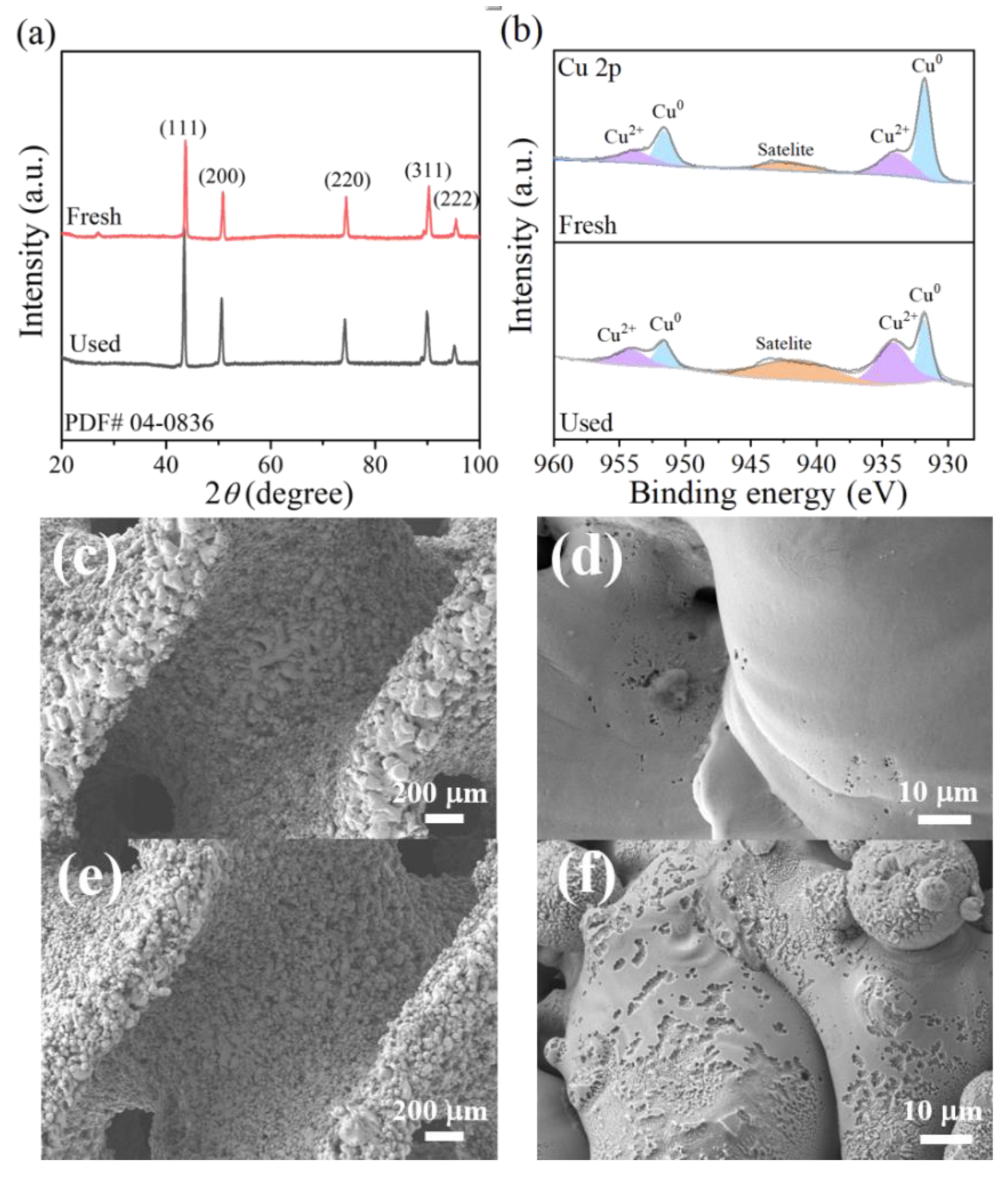
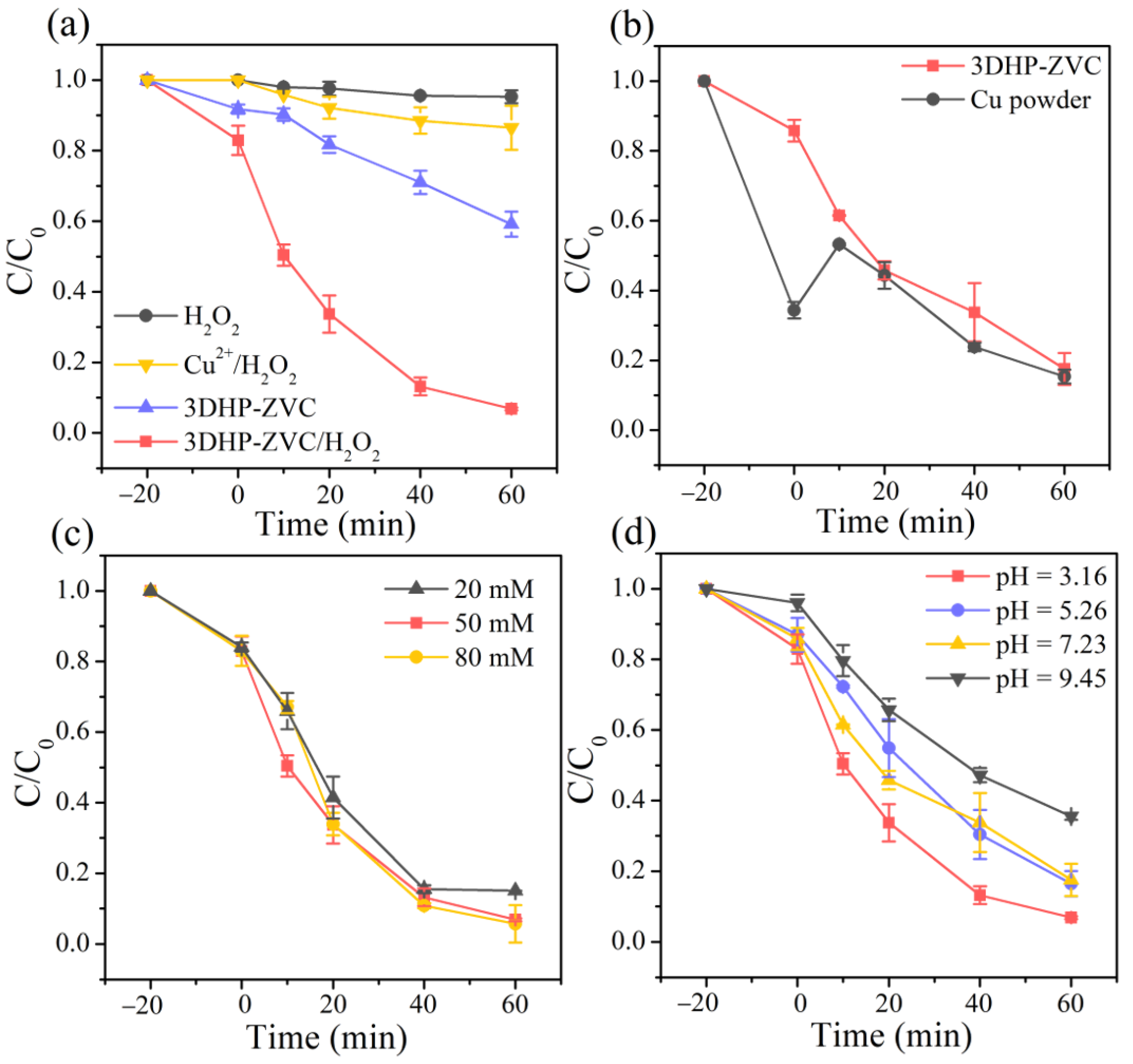
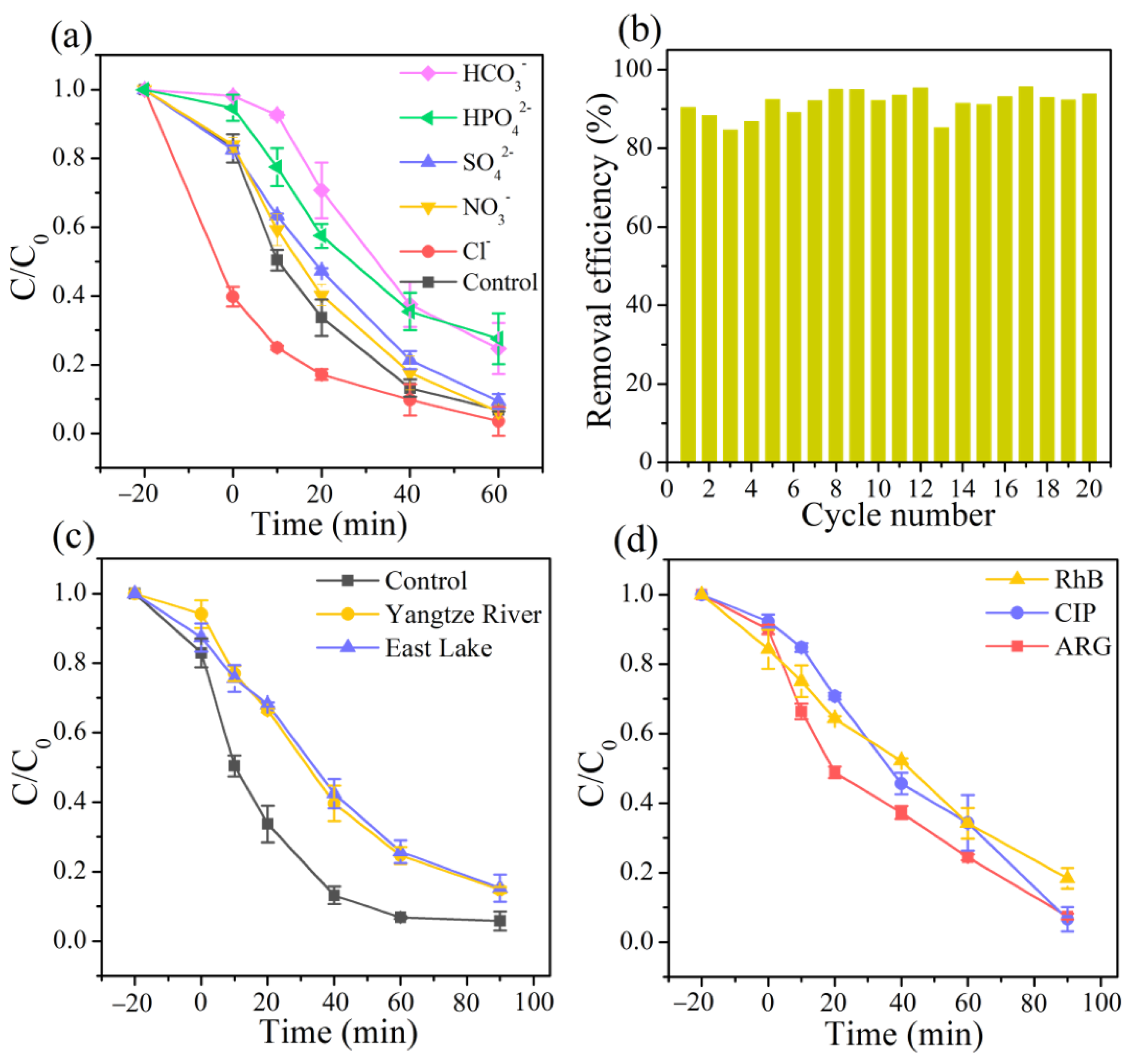
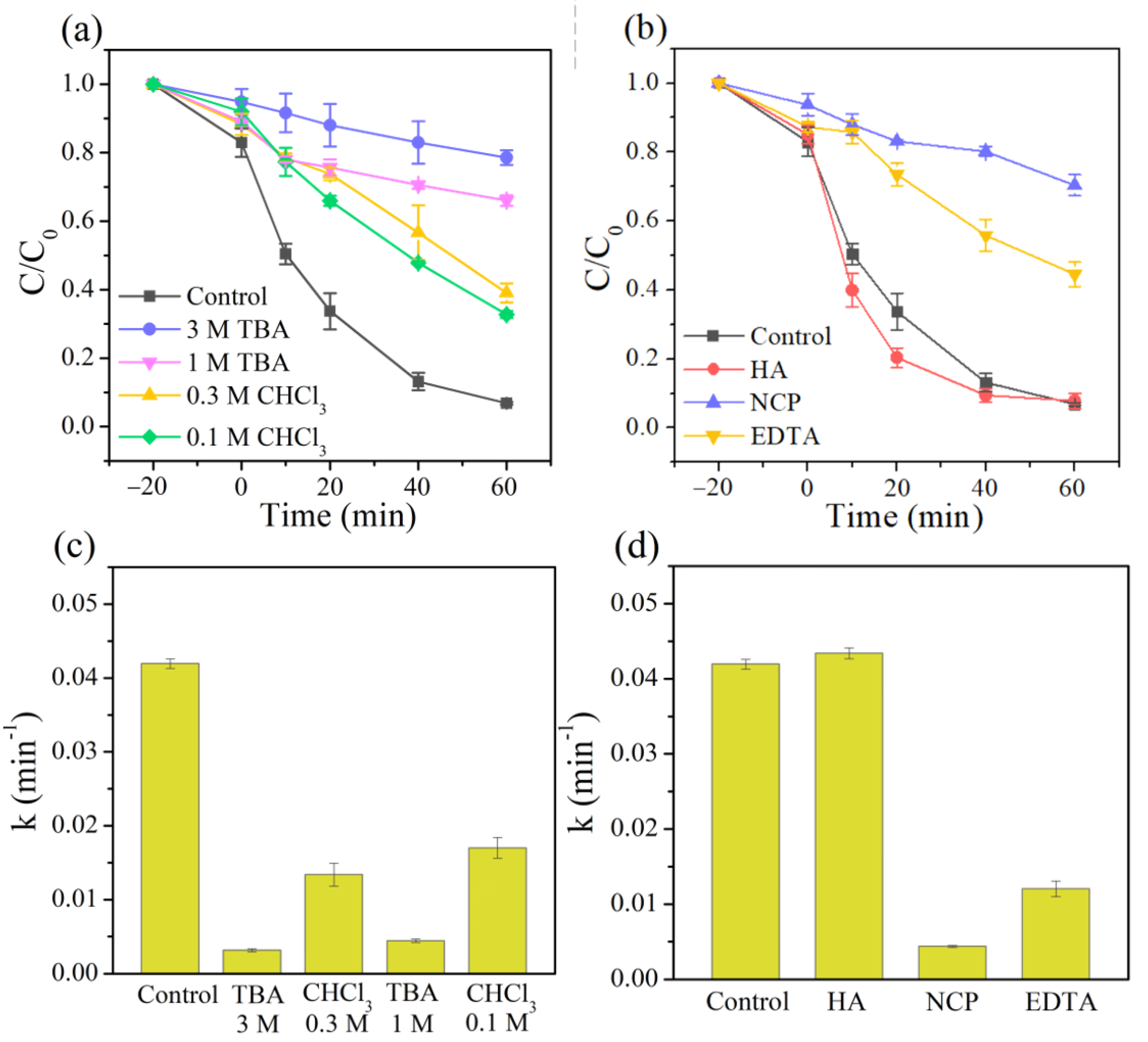
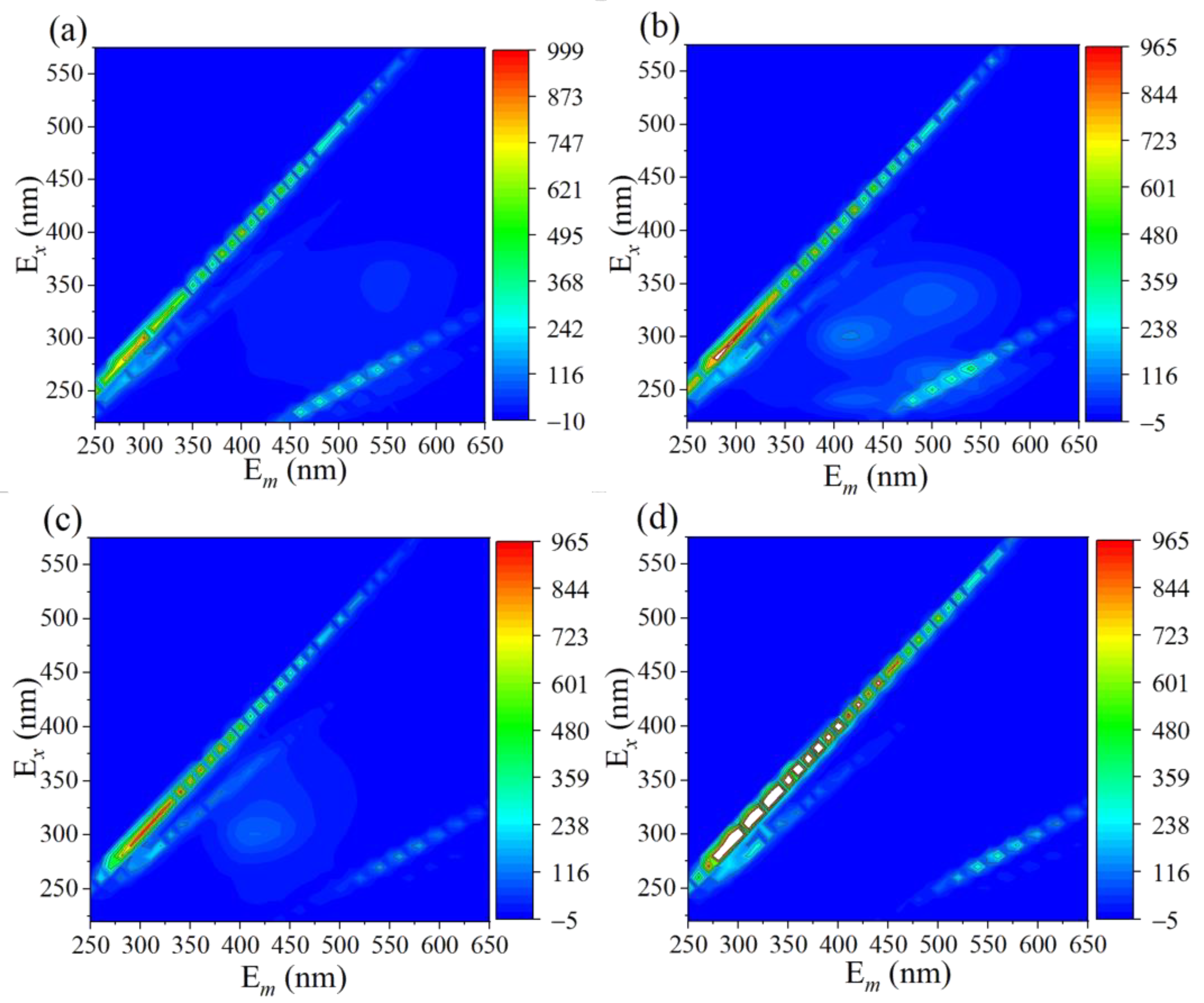

| Catalyst | H2O2 Concentration (mM) | Pollutant Concentration (mg/L) | Removal Efficiency | Cycle Number | Reference |
|---|---|---|---|---|---|
| CuNx | 80 | TC 20 | 93.6% (60 min) | 5 | [35] |
| CuxNiyCo-LDH/GO | 10 | TC 20 | 96.5% (40 min) | 5 | [36] |
| CuFeO QDs/CNNSs | 100 | TC 50 | 99.8% (25 min) | 5 | [37] |
| CuS@GCS ENFC | 67 | TC 10 | 81.3 (120 min) | 4 | [38] |
| ZVC | 10 | Norfloxacin 5 | 46.7% (30 min) | Not available | [39] |
| NPC@DCS (Cu) | 500 | RhB 10 | 100% (60 min) | 5 | [28] |
| nZVC-Cu(II)-rGO | 10 | 2-chlorophenol 10 | 91.8% (60 min) | 8 | [40] |
| 3DHP-ZVC | 50 | TC 10 | 93.2 % (60 min) | 20 | This work |
| Scanning Speed (mm/s) | Laser Power (W) | Layer Thickness (mm) | Hatch Spacing (mm) | Weight (g) | Dimension (mm × mm × mm) |
|---|---|---|---|---|---|
| 600 | 300 | 0.03 | 0.10 | 2.1 | 10 × 10 × 10 |
Disclaimer/Publisher’s Note: The statements, opinions and data contained in all publications are solely those of the individual author(s) and contributor(s) and not of MDPI and/or the editor(s). MDPI and/or the editor(s) disclaim responsibility for any injury to people or property resulting from any ideas, methods, instructions or products referred to in the content. |
© 2023 by the authors. Licensee MDPI, Basel, Switzerland. This article is an open access article distributed under the terms and conditions of the Creative Commons Attribution (CC BY) license (https://creativecommons.org/licenses/by/4.0/).
Share and Cite
Guo, S.; Chen, M.; Huang, Y.; Wei, Y.; Ali, J.; Cai, C.; Wei, Q. Three-Dimensionally Printed Zero-Valent Copper with Hierarchically Porous Structures as an Efficient Fenton-like Catalyst for Enhanced Degradation of Tetracycline. Catalysts 2023, 13, 446. https://doi.org/10.3390/catal13020446
Guo S, Chen M, Huang Y, Wei Y, Ali J, Cai C, Wei Q. Three-Dimensionally Printed Zero-Valent Copper with Hierarchically Porous Structures as an Efficient Fenton-like Catalyst for Enhanced Degradation of Tetracycline. Catalysts. 2023; 13(2):446. https://doi.org/10.3390/catal13020446
Chicago/Turabian StyleGuo, Sheng, Meng Chen, Yao Huang, Yu Wei, Jawad Ali, Chao Cai, and Qingsong Wei. 2023. "Three-Dimensionally Printed Zero-Valent Copper with Hierarchically Porous Structures as an Efficient Fenton-like Catalyst for Enhanced Degradation of Tetracycline" Catalysts 13, no. 2: 446. https://doi.org/10.3390/catal13020446





